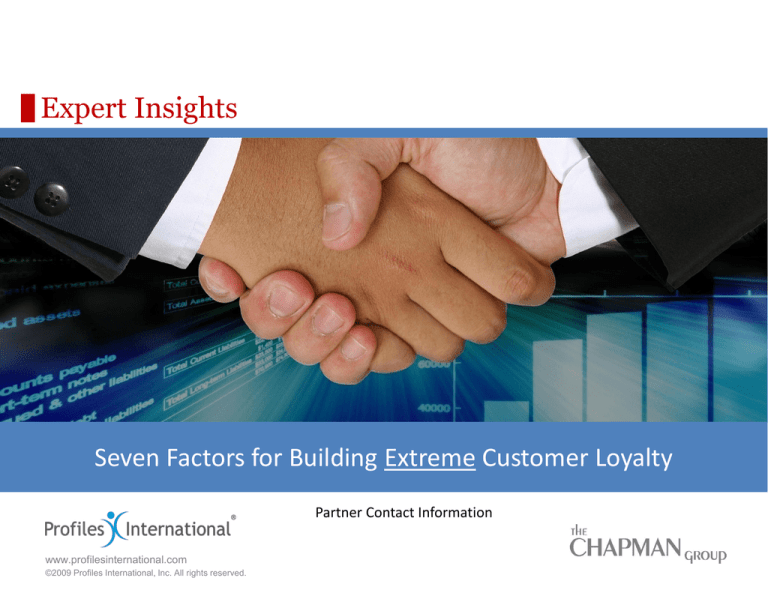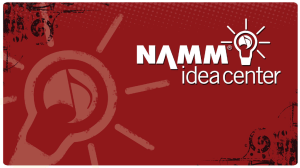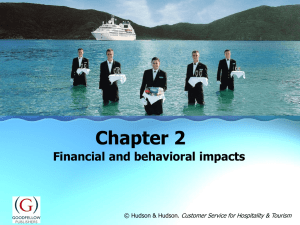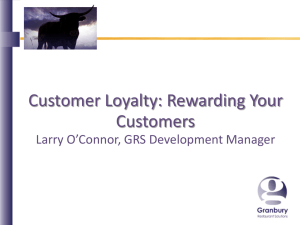
Expert Insights
Seven Factors for Building Extreme Customer Loyalty
Partner Contact Information
www.profilesinternational.com
©2009 Profiles International, Inc. All rights reserved.
Seven Factors for Building Extreme Customer Loyalty. Copyright 2009 by Profiles International. Printed and bound in the United States of
America. All rights reserved. No part of the report may be reproduced in any form or by any electronic or mechanical means including
information storage and retrieval systems without written permission from the publisher.
Publisher
Profiles Research Institute
Dario Priolo, Managing Director
5205 Lake Shore Drive
Waco, Texas 76710-1732
Profiles International
(800) 960-9612
www.profilesinternational.com
Acknowledgements
CEO, Co-founder, Profiles International: Jim Sirbasku
President, Co-founder, Profiles International: Bud Haney
Editor-in-Chief: Dario Priolo
Subject Matter Expert and President, The Chapman Group: Dennis J. Chapman Sr.
Managing Editor: Carrie D. Martinez
Creative Director: Kelley Taylor
www.profilesinternational.com
©2009 Profiles International, Inc. All rights reserved.
Loyalty Indicators | 2
Seven Indicators of Extreme Customer Loyalty
Know Your Customers — Keep Your Customers
A Satisfied Customer is NOT always a Loyal Customer!
For many decades the goal has been satisfied customers . While satisfaction is important, it is not
sufficient to guarantee that your customers will continue to buy from you. The world changes
quickly and the minute you get complacent, BANG, a new competitor surfaces with a solution they
claim is better, faster or cheaper. Suddenly your customer no longer needs you.
We all know it costs a whole lot more to acquire a new customer than to maintain an existing
customer. Existing customers play an even greater role in our ever-changing global economy – we
must keep them and grow them. We know that there are actions we can take and behaviors we can
measure that create long term relationships between sellers and buyers.
So, what really drives customer loyalty?
Josiah Royce, an American philosopher in the mid-to-late 1800’s, claimed that the trait of loyalty
was most often associated with political institutions, religion, war, and family. In these situations,
people had one key influence in common – a passionate link to a “common cause.” We believe that
you build loyalty when you and your customers are aligned on seven key factors. These factors are:
1.
2.
3.
4.
5.
6.
7.
Emotional Dependence
Structural Dependence
Business Dependence
Satisfaction
Performance
Economic Value Proposition
Alignment and Fit
This report expands on these seven indicators, and will help you go beyond simply satisfying
customers to protecting and growing your strategic accounts.
www.profilesinternational.com
©2009 Profiles International, Inc. All rights reserved.
Loyalty Indicators | 3
Seven Indicators of Extreme Customer Loyalty
1. Emotional Dependence
I Will Always Be…E-mo-tion-ally Yours (Bob Dylan)
Emotional Dependence is the psychological commitment from the customer. It is the customer’s reliance on
an organization for support, guidance, and decision-making – the tendency of the customer to see help from
you as a supplier in making decisions or in carrying our difficult actions. When an individual is emotionally
dependent and things do not go as expected, they can distance themselves and seek out a relationship that
provides the support they need. Emotional Dependence includes; integrity, reliability, depth of relationship,
and empathy.
Ritz-Carlton hotels are widely recognized for their exceptional job of creating an emotional bond with their
clients. They make an effort to know you and your preferences, and then go above and beyond your
expectations to satisfy your emotional needs. For example, they may provide you with your local newspaper
instead of a generic USA Today, or they may surprise you by making reservations at your favorite restaurant.
Sometimes the smallest things can make the biggest difference.
Conversely, a negative experience can have a detrimental effect on customer loyalty when you’re in a
heighted emotional state. For example, when your IT staff can’t get the right engineer on a support hotline
after your network has crashed, or if the on-line flower shop botches your order and your wife doesn’t
receive her gift in time for Mother’s Day. These are both performance issues, but the emotional element
magnifies the impact.
How to Create Emotional Dependence
• Learn what your customers value on a personal level and go beyond their expectations to demonstrate
that you care about them.
• Show a high degree of empathy and responsiveness when you sense your customers are getting
emotional about an issue. Even if you can’t solve the problem on the spot, let them know they are
important and that you will do what it takes to satisfy their personal needs.
• Put the right person on the job. This person should be able to connect with the customer on a personal
level. Make sure your employee can provide this support and that you have the right processes in place
for triaging issues. Make the customer feel good about working with your organization.
www.profilesinternational.com
©2009 Profiles International, Inc. All rights reserved.
Loyalty Indicators | 4
Seven Indicators of Extreme Customer Loyalty
2. Structural Dependence
Can You Help Strengthen Your Customers’ Weak Links?
Structural Dependence is the operational foundation of the relationship and consists of people,
facilities, systems, and distribution channels. Structural dependence builds a common cause
between the buyer and seller, and this helps build loyalty.
Accenture is a good example of a company that creates structural dependence by providing
clients a wide range of outsourced IT services. This enables clients to run their businesses more
efficiently and focus on their core business, and it enables Accenture to provide services at a
lower cost by building scale and operating expertise.
UPS is another good example. It has re-positioned itself from a company that merely delivers
packages to one that can manage an organization’s complete supply chain function around the
world. They can do this because they have the people, equipment, facilities, and operational
expertise in an essential function that is difficult for the average organization to manage on its
own.
Once organizations outsource non-core operations to companies such as Accenture and UPS, it
is much more difficult for them to bring these functions back in house because the investment
is high and expertise is scarce. Although switching service providers is possible, it is difficult and
risky. Structural dependence is among the most powerful loyalty builders.
How to Create Structural Dependence
• Understand how your customers’ businesses operate. Then determine where they have
gaps or inefficiencies that would enable you to operate portions of their businesses better,
cheaper and with fewer headaches or risks for your customer.
www.profilesinternational.com
©2009 Profiles International, Inc. All rights reserved.
Loyalty Indicators | 5
Seven Indicators of Extreme Customer Loyalty
3. Business Dependence
You Scratch My Back and I’ll Scratch Yours!
Business Dependence is the marketing positioning of the relationship. This includes how you
help your customer create go-to-market solutions, grow and retain their customers, and be
competitively sound in their market.
The relationship between Apple and AT&T is a good example of business dependence. When
Apple decided that it wanted to launch the iPhone, it entered into an exclusive distribution
agreement with AT&T. Apple distributed the iPhone through AT&T’s massive retail network and,
in turn, AT&T built its subscriber base by attracting customers from competing providers, such
as Verizon and T-Mobile, who couldn’t offer the iPhone. By combining forces to sell the iPhone
through the AT&T sales channel, both organizations benefitted significantly.
Another good example is the business dependence between a pure-play biotechnology firm,
such as Amgen, and the “big pharma” company Wyeth. Wyeth has a large sales force that goes
door-to-door calling on doctors and keeping Wyeth drugs top-of-mind. However, they have
issues with their drug development pipeline, especially in new and emerging fields such as
biotechnology. Conversely, Amgen had deep expertise, but lacked a sales and market presence.
By combining forces to market certain Amgen drugs through the Wyeth sales force, both
organizations benefitted significantly.
How to Create Business Dependence
• Identify areas where your customer is weak but you are strong, as well as areas where you
are weak and your customer is strong. After conducting this analysis, identify opportunities
for building on each other’s strengths and minimizing each other’s weaknesses. Then, start
to envision how the relationship would work operationally and financially to build mutual
value.
www.profilesinternational.com
©2009 Profiles International, Inc. All rights reserved.
Loyalty Indicators | 6
Seven Indicators of Extreme Customer Loyalty
4. Satisfaction
Customer Satisfaction Influences Loyalty, but it isn’t the Only Predictor
Customer Satisfaction is often an indication of how well your organization performed during a
recent event. This often includes elements of service, support and delivery - delivering a new
product or service; solving a service or maintenance issue; or executing a campaign, pilot
program or evaluation.
For example, JD Power and Associates is well-known for its customer satisfaction surveys on
automobiles, consumer electronics and financial services. Among the most widely known are
Power Circle Ratings related to the J.D. Power and Associates Initial Quality StudySM, which
measure consumer perceptions of automotive new-vehicle quality after 90 days of ownership.
Power Circle Ratings are important and influential measures, but a high score doesn’t necessarily
mean that customers will be loyal to the model or the brand. Customer Satisfaction measures are
too limited to be an accurate predictor, especially when it comes to complex business solutions.
Satisfaction ratings are important because we need to know that if we’ve been tasked to deliver
something, we have successfully done so. But we need to be careful that we don’t use that as
the only driver or only metric of our loyalty assessment.
How to Create High Customer Satisfaction
• Creating high customer satisfaction starts with a careful assessment to determine needs and
uncover expectations with regard to price, impact and level of service. Then you must meet or
exceed expectations. “How” you deliver can be as important as “what” you deliver, so don’t
underestimate the impact emotions play in satisfaction scores. Formal surveys and properly
designed questionnaires are a big help.
www.profilesinternational.com
©2009 Profiles International, Inc. All rights reserved.
Loyalty Indicators | 7
Seven Indicators of Extreme Customer Loyalty
5. Performance
Not Too Hot, Not Too Cold – Just Right!
“Performance“ refers to how a product or service holds up to expectations and required
industry standards. Measurements of performance can include meeting ISO and Six Sigma
requirements. Typically, performance is measured over a longer period of time and with more
objective criteria than the measurement of satisfaction, which is event-based and emotionally
influenced.
Performance is important, but is not the sole predictor of loyalty. For example, BMW makes
some outstanding automobiles that perform superbly when it comes to acceleration, braking,
handling and quality. All of these can be measured against a standard.
However, “The Ultimate Driving Machine” is tuned with a stiff suspension that makes for a ride
that is too hard for some people. Catch a person who is tired of feeling every bump in the road
and he may tell you that he would prefer a Lexus the next time he’s in the market for a new car.
Know What Matters and What is Expected
It is also important to know which performance factors really matter to your customers and
which don’t. Your customers might not care that you have a 97% on-time delivery rate for air
freight if they sell a bulk product that can only go by ground.
For the factors that do matter to your customers, it is important to understand how your
customers define different performance levels and their minimum acceptable performance
criteria. From the example above, don’t assume that a 97% on-time delivery rate for your air
freight service is acceptable. Your customer might need 98% and your competition might boast
99%. Find out where you stand, so you know for sure.
www.profilesinternational.com
©2009 Profiles International, Inc. All rights reserved.
Loyalty Indicators | 8
Seven Indicators of Extreme Customer Loyalty
6. Economic Value Proposition
Show Me the Money
Economic Value Proposition refers to the financial implications in the relationship with a
customer, such as the economic impact of having or not having a supplier’s products or
services. In better words, it answers the question, “How do we help each other make more
money and stay in business?”
A customer who has a great appreciation for the return on her investment in your solution will
have a higher propensity to remain a customer. You typically help her create value through one
or more of the following three ways:
1. How you help them reduce expenses
2. How you help them avoid expenses
3. How you help them increase revenue and profit
When value creation is a mutual goal then loyalty prospers; but when value is one-sided,
loyalty suffers. For example, if your customer only buys from you at the lowest possible price,
ties-up your support resources, and pays only after repeated collection calls, then you’ll feel
taken advantage of. In fact, you may come to the conclusion that you can’t afford to keep them
as a customer and therefore look to fire them before they bankrupt you.
How to Create Mutual Economic Value
• Collaborate with your customers to understand how your solutions are impacting them.
Then ask yourself, “What’s the impact of having or not having this solution?” It is very
important to document this information and validate it with the client, and then ensure that
this is communicated inside the customer organization. The more people inside your
customer organization that understand the value you bring, the more loyal they will be.
www.profilesinternational.com
©2009 Profiles International, Inc. All rights reserved.
Loyalty Indicators | 9
Seven Indicators of Extreme Customer Loyalty
7. Alignment and Fit
Custom fit or off the rack?
Alignment and Fit in a buy/sell relationship includes factors such as shared mission and vision,
culture, collaborative practices, leadership and expectations. The higher the degree of
alignment and fit, the greater the degree of loyalty.
For example, Google is a company that places a high value on innovation; but they also highly
value intellectual and technical rigor. They have grown organically and have a rigorous selection
process that enables them to create a consistent corporate culture.
On the other hand, Oracle has grown through acquisitions. The company is in a perpetual state
of flux where the culture is aggressive and much more individualistic. Those who can deliver
technological breakthroughs or land the 7-figure deals are praised while others walk.
These are two very successful companies with two very distinct cultures. Expect them to
behave differently as customers and understand that you might “fit” better with one than the
other. It does not mean that you walk away from those with whom you do not fit, but you will
probably need to work harder and endure some discomfort.
How to Create Alignment and Fit
• First, you need to know yourself. Think back to the customers who work best with you. Why
do you believe this is the case? Are there any common characteristics? Conversely, can you
identify the customers you wish would go away? Are there any common characteristics that
predict poor fit? Then use your criteria to segment your accounts into those who fit well and
those who do not. Ask your customers “fit” questions as part of your strategic account
planning process and manage them accordingly.
www.profilesinternational.com
©2009 Profiles International, Inc. All rights reserved.
Loyalty Indicators | 10
Seven Indicators of Extreme Customer Loyalty
Important Rules for Applying the 7 Indicators
Bringing Your Customer Loyalty Program to Life
1. You don’t need to track all 7 indicators
Each company is unique and for that reason you may not be able to measure all 7 Loyalty
Indicators. It is recommended that you track a minimum of 5 and track all 7 when appropriate.
For example, in some organizations Performance or Alignment and Fit may not be measurable
– or even appropriate to measure.
2. Gather insights from multiple contacts in an account
Having multiple points of contact within an account is a sign of a healthy account. It is very
important to gather insights from multiple players in the customer organization to get the most
accurate measure of loyalty. Large differences between groups signals a major issue.
3. Knowledge + Relationships + Economic Value = Exponential Success
Your success in an account will increase exponentially as you increase your collective
knowledge, relationships and economic value. Remember, a strategic account is an extremely
valuable asset and must be managed accordingly.
4. Prioritizing your loyalty building activity
• Where are you today?
• Where do you need to go?
• What needs to happen to get there?
www.profilesinternational.com
©2009 Profiles International, Inc. All rights reserved.
Loyalty Indicators | 11
“
Summary of Lessons Learned:
An ounce of
loyalty is
worth a
pound of
cleverness.
“
Elbert Hubbard
Seven Indicators of Extreme Customer Loyalty
1. Emotional Dependence
2. Structural Dependence
3. Business Dependence
4. Satisfaction
5. Performance
6. Economic Value Proposition
7. Alignment/Fit
www.profilesinternational.com
©2009 Profiles International, Inc. All rights reserved.
Loyalty Indicators | 12
imagine great
™
people
Profiles International – Who We Are
The Chapman Group
Profiles International helps organizations
worldwide create high-performing workforces.
The Chapman Group helps organizations
optimize field sales performance.
Through our comprehensive employment
assessments and innovative talent management
solutions, our clients gain a competitive
advantage by selecting the right people and
managing them to their full potential.
Our core competencies include:
• Strategic Account Management
• Sales Training and Management Coaching
• Account Loyalty Assessments
• Metric-based sales performance and
diagnostic software tools
Contact Us
Contact Us
The Chapman Group
www.chapmanhq.com
Partner Contact Information
www.profilesinternational.com
©2009 Profiles International, Inc. All rights reserved.
Loyalty Indicators | 13
About Profiles International
Products of Interest
LoyaltyPro™ is a web-based customer loyalty surveying tool. Loyalty, as determined through the
“voice of the customer”, is a leading indicator that predicts the “staying power” of an account.
LoyaltyPro™ offers companies a tool to gather ongoing , critical account intelligence that helps to
assess the relationship between the buyer and the supplier, ultimately driving customer improvement
action plans. Having insight into your customer’s perception of your relationship allows you to steer
strategic business efforts and initiatives of the account team to continually improve customer
relationships and build a network of loyal customers.
Customer Service Profile (CSP) – measures key characteristics of exceptional customer service. How
much easier is it to drive performance when the people engaging the customer on a daily basis are all
on the same page? The CSP looks at what our current and future employees believe is a high level of
customer service, while at the same time showing us where they align (or not) with our company’s
perspective.
www.profilesinternational.com
©2009 Profiles International, Inc. All rights reserved.
Loyalty Indicators | 14










